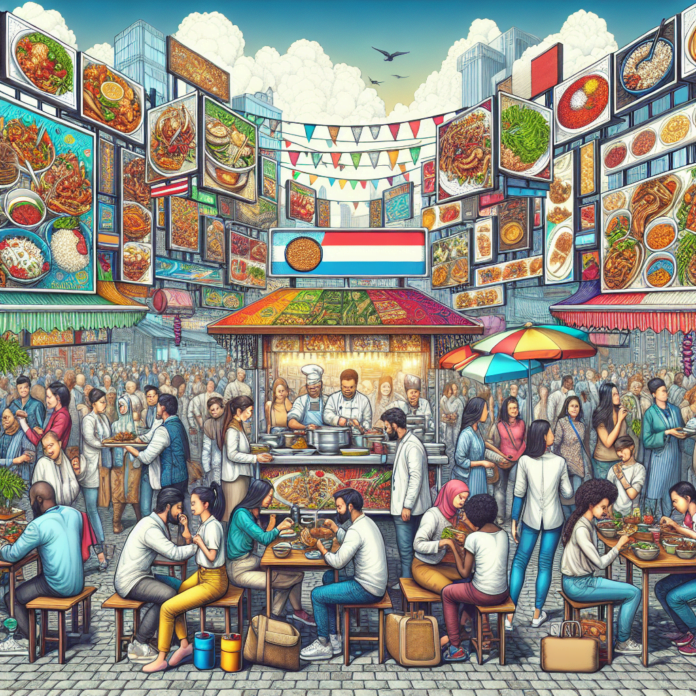Street food culture is a fascination for both chefs and food enthusiasts across the globe. Every country has its authentic street food scene, which stands as a testament to its culinary culture. The stir of sizzling pan, the waft of condiments and spices, the throng of locals impatiently awaiting their favorite snack – street food culture is unraveled steps and is as unique as the food it offers.
Be it the bustling streets of Bangkok, the aromatic lanes of Istanbul, the vibrant markets of Mexico or roadside hawkers in India, street food reflects the rich heritage and diverse flavors of a place. Apart from being delicious and affordable, it embodies the essence of local cuisine and gives a glimpse into a nation’s socio-economic fabric.
Asia’s Street Food Haven
In the Asian continent, street food portrays not just gastronomy but the lifestyle of the people. Countries like Thailand, Vietnam, Singapore, and India are famous for their street food culture. Bangkok’s streets at night line up with stalls offering Pad Thai, Satay, and other assortments. The night markets of Taiwan, such as Shilin, are particularly well-known for their ‘Xiao Chi’ (little eats) that includes bubble tea, Kung Pao chicken, and more.
The streets of Vietnam offer a variety of noodle soups, where each region has a unique style. Pho and Banh Mi sandwiches are popular Vietnamese street foods known internationally. India’s chaats, dosas, and other street foods are renowned for their flavors, rooted in regional diversity. Korean streets offer delicacies like Tteokbokki (rice and fish cakes in spicy sauce), while Japan is famous for its Takoyaki (octopus balls) and Yakitori stalls.
Europe: Fusion of Taste and Culture
European countries have their distinct essence in their street food culture, reflecting their ethnolinguistic diversity. From the French Crepe, German Bratwurst, British fish and chips to the array of cheese in Italian markets and Spanish tapas, Europe’s streets have much to offer. The steaming pretzels sold by street vendors in Germany and the Baklava stalls in Istanbul are absolute delights.
Americas and the Street Food Fiesta
North and South America have a diverse street food culture. Mexican street food is one of the most renowned, with Tacos and Corn on the cob (Elote) being some of the many mouth-watering treats. Argentina’s Choripan, a sausage sandwich, and Brazil’s Pastel, a street food pastry, are examples of the fusion of flavors in South America. In the US, the food truck culture represents the modern street food scene serving a variety of cuisines, including but not limited to hot dogs, burgers, and ethnic foods.
A Taste of Africa
In Africa, street food is ubiquitous. Influences from Arab, Asian, and European cuisines can be seen in the dishes prepared. From Jollof Rice in West Africa to Bunny Chow in South Africa, each region has its influence. Tanzania’s Zanzibar Pizza and Morocco’s Shawarma holds a unique place in the menu of street food lovers.
Street Food as a Culinary Journey
Exploring the street food of a place can be a wholesome and authentic experience. Enjoying street food means supporting local businesses, understanding local ingredients and preparations, and engaging in the life of the local community. It’s a culinary journey that transcends boundaries, blending one culture with another. It’s an art of celebrating life, enjoying food, and creating everlasting memories.
Conclusion
Embarking on a culinary journey through the streets of the world unveils a new facet of culinary art. It enriches an individual not only by satiating their taste buds, but also by enlightening them about a culture’s history, practices, and daily life. It’s a tapestry of not only food, but tales of tradition, of people, their lives, culture and love for food. So, next time you’re travelling or perhaps exploring your own homeplace, delve into the street food scene and treat yourself to a journey of flavors that you’ll never forget.
Frequently Asked Questions(FAQs)
What is Street Food?
Street food refers to prepared or cooked food sold by vendors in a street or other public location for immediate consumption. It often represents local cuisine and can be found globally.
Which Asian country has the best street food?
While it’s subjective and depends on one’s taste, Thailand, Vietnam, and India are often renowned for their vibrant street food scenes.
Is street food safe to eat?
Generally, street food is safe to eat. However, it varies with countries and stalls. It’s advised to eat at busy places where food turnover is faster, to ensure its freshness.
What makes street food popular?
Street food is popular for its affordability, convenience, variety, and unique taste. It also provides an authentic representation of local cuisine and culture.

